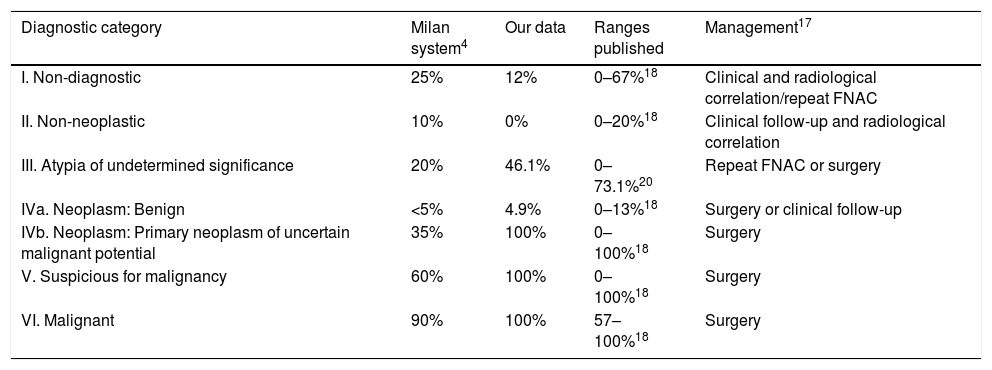Fine needle aspiration cytology (FNAC) is an established technique in the management of salivary gland lesions. The Milan System for reporting salivary gland cytopathology (MSRSGC) intents to standardize diagnostic categories. Current studies are trying to evaluate the diagnostic approach of this system.
MethodsFNAC of salivary gland lesions were retrieved over an 11-year period. 185 FNAC specimens from 182 patients were reviewed blindly and classified according to the criteria established by the MSRSGC. 136 (74.7%) patients had follow-up of their processes.
ResultsThe total number of diagnostic categories and risk of malignancy (ROM) in 185 specimens were the following: non-diagnostic 39 (21.1%; ROM 12%), non-neoplastic 35 (18.9%; ROM 0%), atypia of undetermined significance (AUS) 17 (9.2%; ROM 46.1%), benign neoplasm 75 (40.5%; ROM 4.9%), salivary gland neoplasm of uncertain malignant potential 4 (2.2%; ROM 100%), suspicious for malignancy 7 (3.8%; ROM 100%), malignant 8 (4.3%; ROM 100%). No false positives were observed in groups IVb, V, and VI in this series. The overall sensitivity, specificity, negative predictive value, positive predictive value and diagnostic accuracy were 88%, 91.8%, 96.3%, 76.7%, and 91% respectively.
ConclusionThe ROM reported in our study was in keeping with ROM published by the MSRSGC. This system provides standardized information for risk stratification. The category AUS encompassed cases causing uncertainty representing a challenge in management. Defining criteria for AUS category need to be refined. The system facilitates communication between pathologists and clinicians favoring improvement in patient care.
La citología por punción-aspiración con aguja fina (PAAF) está establecida en el tratamiento de las lesiones de las glándulas salivales. El sistema Milán (SM) intenta homogeneizar las categorías diagnósticas en los informes citológicos. Los estudios actuales están tratando de evaluar el enfoque diagnóstico de este sistema.
MétodosSe revisaron las PAAF de las glándulas salivales obtenidas durante un período de 11 años. Se revisaron a ciegas 185 muestras de PAAF de 182 pacientes, y se clasificaron de acuerdo con los criterios establecidos por el SM. Se realizó seguimiento de los procesos de 136 (74,7%) pacientes.
ResultadosLos totales de categorías diagnósticas y el riesgo de malignidad (ROM) en 185 muestras fueron los siguientes: no diagnóstico 39 (21,1%; ROM 12%), no neoplásico 35 (18,9%; ROM 0%), atipia de significación indeterminada (ASI) 17 (9,2%; ROM 46,1%), neoplasia benigna 75 (40,5%; ROM 4.9%), neoplasia de potencial maligno incierto 4 (2,2%; ROM 100%), sospecha de malignidad 7 (3,8%; ROM 100%), malignidad 8 (4,3%; ROM 100%). No se observaron falsos positivos en los grupos IVb, V y VI. Los valores de sensibilidad, especificidad, el valor predictivo negativo, el valor predictivo positivo y la precisión diagnóstica fueron del 88%, 91,8%, 96,3%, 76,7% y 91%, respectivamente.
ConclusiónEl ROM observado concordaba con el ROM publicado por el SM. Este proporciona información estandarizada para la estratificación del riesgo. La categoría ASI abarcó los casos que causaron incertidumbre, y representa un desafío en el manejo de los pacientes. Los criterios de definición de ASI deberían perfeccionarse. El sistema facilita la comunicación entre patólogos y clínicos, y mejora la atención al paciente.









